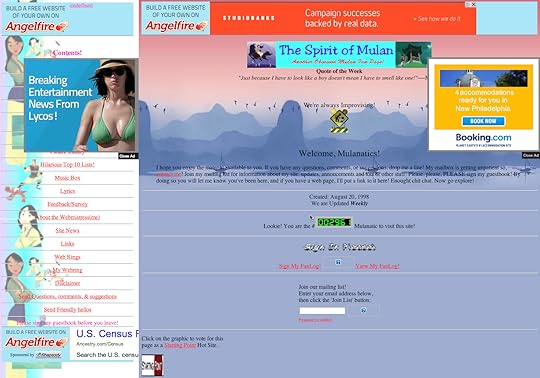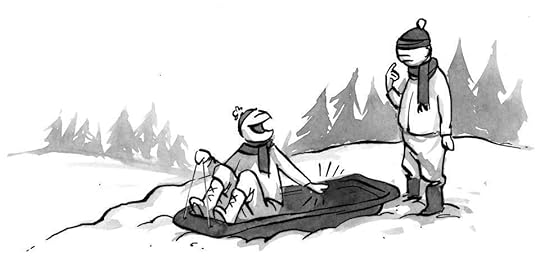Jeffrey Zeldman's Blog, page 42
September 26, 2013
Big Web Show № 97: Research For Tomorrow with Erika Hall
IN EPISODE № 97 of The Big Web Show, Erika Hall (Just Enough Research, Mule Design Studio) and I chat about why funding startups nobody needs is killing innovation; how designers can use research to stop bad ideas and find great ones; Russell Brand; and the secret history of Unsuck It.
September 24, 2013
A List Apart № 383: It Ain’t Easy Being Green
A LIST APART № 383 tackles our impact on the biosphere:
Sustainable Web Design
by JAMES CHRISTIE
Do you know your website’s carbon footprint? Or how to lower it? Emissions standards have been set for the automotive, construction, and telecommunications industries, yet the internet’s carbon footprint is growing out of control: a whopping 830 million tons of CO2 annually—larger than that of the entire aviation industry. At least 40 percent of that falls partially under the responsibility of people who make websites. It’s time for web designers to do our part. James Christie explains how to slim our obese websites and simultaneously attack our industry’s carbon footprint, using methods that conveniently dovetail with good business practice and future-friendly design.
The Web Runs on Electricity and We’re Running Out
by DORIAN PETERS
It’s a humbling thought, but as web professionals, nothing we create actually exists when the power goes out. As we increase the number of devices in our world, planning for a connected web of things in hopes that the poor will be liberated, education will be free, and our fridges will tell us we’re out of lettuce, we fail to acknowledge that we scarcely have enough fossil fuels to maintain the current state for long. Web designers need to be part of the solution—and the situation is more hopeful than you may think. Dorian Peters shows how we can exercise the surprising power that lies in seemingly small designerly decisions to help our industry not only survive, but create positive impact worldwide.
September 20, 2013
Dispossessed
@kirilnyc @naveen Soho Apple store circa 11:30pm pic.twitter.com/Q0PAKflG9A
— Jordan Elpern-Waxman (@jelpernw) September 20, 2013
“HOMELESS FOLK sleeping in front of the SoHo Apple Store. What a perfect commentary on our society,” I thought. Then I realized these aren’t the homeless. They’re upwardly mobile consumers vying to be the first to buy a new model iPhone when the store opens in the morning.
September 19, 2013
That’s Me All Over
BY SOME FLUKE I appear in two internet radio broadcasts this week:
The Gently Mad Podcast: Jeffrey Zeldman
“Jeffrey Zeldman is an author, designer and founder of Happy Cog. He talked with Adam about the state of the web industry, how it has changed over the years and how raising a daughter has impacted his outlook on who he is and what he does.” I loved this conversation with Adam.
Why Designers need to Craft Words Not Pixels
“Design is a point of view.” In this 53-minute internet audio conversation, William Channer and I discuss how words and stories frame web experience; how I approach writing for the web; how good copy teases interest; and why making your content the focus, and removing distractions, engages readers and improves web experience.
Click It
HERE’S A WEBSITE one of my students designed when she was in Seventh Grade. (She’s 27 now.) Notice that Angelfire still sells ads on it. Wonder how well they perform.
September 16, 2013
Just The Two Of Us: Monteiro & Me on Big Web Show No. 96
IN EPISODE No. 96 of The Big Web Show (“everything web that matters”), I chat with my friend Mike Monteiro, author of Design Is A Job, and co-founder of Mule Radio, about the joy of client services; how to sell great work; the relaunch of the show on the Mule Radio Network; and the one weird secret that all the best-loved applications, services, and content sites have in common. Enjoy the show.
URLS
About Mike Monteiro
Mule Radio Network
Design Is A Job
First 95 Big Web Show Episodes on the 5by5 Network
Photo of Mike and Jeffrey at Marciland, Seattle, 2013 © Daniel Mall.
September 7, 2013
The Lords of Vendorbation
Vendorbation
ven·dor·ba·tion
/ˈvendər-ˈbā-shən/

noun : Unusable web-based intranet software foisted on large populations of users who have no say in the matter. For example, the “dynamic” website for your kid’s school, on which you can never find anything remotely useful—like her classroom or the names and email addresses of her teachers. Merely setting up an account can be a Borgesian ordeal minus the aesthetics.
Tried updating a driver’s license, registering a name change after a marriage, or accomplishing pretty much any task on a local, state, or federal website? Congratulations! You’ve been vendorbated. In ad sales? In publishing? Travel agent? Work in retail? Y’all get vendorbated a hundred times a day. Corporate America runs, not very well, on a diet of dysfunctional intranets sold by the lords of vendorbation.
Terrible food kills a restaurant. Terrible music ends a band’s career. But unspeakably terrible software begets imperial monopolies.
Wholesale contractual vendor lock-in between vendors of artless (but artfully initially priced) web software and the technologically unknowing who are their prey (for instance, your local school board) creates a mafia of mediocrity. Good designers and developers cannot penetrate this de-meritocracy. While they sweat to squeeze through needle’s eye after needle’s eye of baffling paperwork and absurd requirements, the vendorbators, who excel at precisely that paperwork and those requirements, breeze on in and lock ‘er down.
Vendorbation takes no heed of a user’s mental model; indeed, the very concept of a user’s mental model (or user’s needs) never enters the minds of those who create vendorbatory software. I say “create” rather than “design,” because design has less than nothing to do with how this genre of software gets slapped together (“developed”) and bloated over time (“updated”).
Vendorbatory product “design” decisions stem purely from contingencies and conveniences in the code framework, which itself is almost always an undocumented archipelago of spaghetti, spit, and duct tape started by one team and continued by others, with no guiding principle other than to “get it done” by an arbitrary deadline, such as the start of a new school year or the business cycle’s next quarter.
Masturbation, or so I have read, can be fun. Not so, vendorbation. It is a nightmare for everyone—from the beleaguered underpaid lumpen developers who toil in high-pressure silos; to the hapless bureaucrats who deserve partners but get predators instead; from the end users (parents, in our example) who can never do what they came to do or find what they want, and who most often feel stupid and blame themselves; to the constituents those users wish to serve—in our example, the children. Will no one think of the children?
Cha-ching! Like a zombie-driven un-merry-go-round spinning faster and faster as the innocents strapped to its hideous horses shriek silently, the vendorbation cycle rolls on and on, season after bloody season, dollar after undeserved dollar, error after error after error after error in saecula saeculorum.
Think it’s bad now? Wait till the lords of vendorbation start making their monstrosities “mobile.”
Doff of the neologist’s toque to Eric A. Meyer, whose cornpensation helped crystalize what to do with the bad feelings.
August 30, 2013
Chicago, Chicago
AN EVENT APART Chicago—a photo set on Flickr. Pictures of the city and the conference for people who make websites.
Notes from An Event Apart Chicago 2013—Luke Wroblewski’s note-taking is legendary. Here are his notes on seven of the ten presentations at this year’s An Event Apart Chicago.
#aeachi—conference comments on Twitter.
Chicago (Foursquare)—some of my favorite places in the city.
An Event Apart Chicago—sessions, schedule, and speaker bios for the conference that just ended.
AEA Chicago 2013 on Lanyrd—three days of design, code, and content on the social sharing platform for conferences.
THE NEXT AEA event takes place in Austin and is already sold out (although a few spaces are still available for the full-day workshop on multi-device design).
A handful of seats are available for the final event of the year, An Event Apart San Francisco at the Palace Hotel, December 9–11, 2013. Be there or be square.
August 28, 2013
Research Engine Optimization
IN ISSUE No. 381 of A List Apart for people who make websites:
Connected UX
by AARRON WALTER
Your inbox overflows with customer emails suggesting features and improvements. Instead of benefiting, you feel overwhelmed by an unmanageable deluge. You conduct usability tests, user interviews, and competitive analyses, creating and sharing key insights. Yet within months, what you learned has been lost, forgotten, or ignored by someone in a different department. What if you could sift, store, and share all your customer learning in a way that breaks down silos, preserves and amplifies insights, and turns everyone in your organization into a researcher? MailChimp’s user experience director Aarron Walter tells how his team did it. You can, too.
Seeing the Elephant: Defragmenting User Research
by LOU ROSENFELD
Silos: good for grain, awful for understanding customer behavior. Just as we favor the research tools that we find familiar and comfortable, large organizations often use research methods that reflect their own internal selection biases. As a result, they miss out on detecting (and confirming) interesting patterns that emerge concurrently from different research silos. And they likely won’t learn something new and important. IA thought leader Lou Rosenfeld explains how balance, cadence, conversation, and perspective provide a framework enabling your research teams to think across silos and achieve powerful insights even senior leadership can understand.
August 13, 2013
Vision & Flow: ALA 380
IN Issue No. 380 of A List Apart for people who make web sites:
Getting to Flow
by BREANDÁN KNOWLTON
Projects go much better when you and your client are in a flow state. But how can you get there? Breandán Knowlton believes the conditions for creating good work aren’t a mystery, and that with a few thoughtful changes you can make those conditions more likely to occur on your next project.
Defining a Vision: Making Sure Your Work Matters
by RUSS STARKE
Knowing how temporary digital creations can be, how can we ensure our work matters? By defining a vision for the organization. Russ Starke explains.










